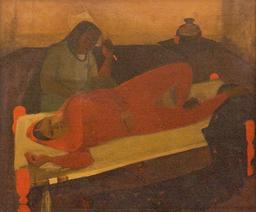Uski Roti (1969)
Director: Mani Kaul; Writer: Mani Kaul, Mohan Rakesh; Producer: Rochak Pandit; Cinematographer: K.K. Mahajan; Editor: Hemant Bose; Cast: Gurdeep Singh, Garima, Richa Vyas, Lakhanapal, Savita Bajaj
Duration: 01:41:18; Aspect Ratio: 1.500:1; Hue: 91.899; Saturation: 0.039; Lightness: 0.326; Volume: 0.052; Cuts per Minute: 6.150; Words per Minute: 10.098
Summary: Based on Mohan Rakesh's short story.
Kaul’s debut is an adaptation of a short story by the noted Hindi author Mohan Rakesh and is perhaps the first consistently formal experiment in Indian cinema. The burly bus driver Sucha Singh (G. Singh) travels through the dusty, flat Punjabi countryside. His wife Balo (Garima) spends long hours waiting for him at the bus-stop with his food packet. One day her younger sister is sexually molested, causing Balo to arrive late at the bus-stop. Sucha Singh is upset by her late arrival, rejects her food and drives away. She remains standing at the roadside until nightfall. The original story uses many stereotypes for both its characters and situations. The film, however, integrates the characters into the landscape, evoking an internalised yet distanced kind of realism reminiscent of Robert Bresson, cf. the shots from within the bus showing the road and the countryside going by while a little sticker on its window intrudes in the corner of the frame. Kaul wanted to discover ‘what was truly cinematic in the filming of a play’ (1974) and he used a minimum of gestures to enact the rigidly notated script. The two registers of Balo’s physical and mental environment are represented by two camera lenses: the 28mm wide-angle deep-focus lens and the 135mm telephoto lens leaving only a minute section of the frame in focus. This schema was gradually reversed through the film, making it Indian cinema’s most controlled achievement in image composition. Its use of spatial volume refers to the large canvases of the modernist painter Amrita Sher-Gil while the soundtrack isolates individual sounds to match the equally fragmented visual details. The film, financed by the FFC, was violently attacked in the popular press for dispensing with familiar cinematic norms and equally strongly defended by India’s aesthetically sensitive intelligentsia.

Formal experiments in New Cinema
Introductory 'guava' sequence.

Introduction of Balo, and the two kinds of cuts that would be Kaul's signature: from Long shot to mid-shot along the same axis, and 90-degree cuts.

Clip #1: Intro Balo, beggar/"daata", covers food bundle.

Second instance of LS-CU and 90-degree cuts.

The food bundle sequence

The wayside seller of hooch (the film's producer Rochak Pandit played that role).

Returning to the bundle of food.

Sucha Singh and the cramped room.

Cramped room contrasts with open fields.

The atta-making - prelude to Jinda's re-entry.

Balo and Jinda - Jinda's guilt, Balo's tragic condition.

The wastrel Jangi. The famous splash.

Formal experiments in New Cinema
The loud splash when he throws the caterpillar into the well.

Second encounter between Jinda and Jangi.

Jinda's direct-to-camera testimony

The bus ride and the cutout of the child Krishna on the windscreen

Balo at the bus stop - second sequence.

Jinda and Balo

Second walk through the fields.
Formal experiments in New Cinema
The Sikh in the fields episode: Balo's insecurities now move to higher level.

Fear: Balo and the beggar

The cards playing sequence with Sucha Singh

Balo and Jinda: They discuss Sucha Singh: 'men have a lot of expenses'.

Balo's first major phantasy. Her desires merge into her phantasies about what Sucha Singh is doing. Her own dream merges into the low shot of the trees, and then Sucha Singh in a room, presumably with his lover.
Formal experiments in New Cinema

My edit

Balo is rejected by Sucha Singh

Balo enters psychotic space. The beggar, the fields, the repudiation and the fear now coalesce in her walk.

Balo retreats into an almost catatonic situation: on the bed.

Woman on Charpoy reference to Amrita Sher-Gil:


Balo's subjective interior: shots perhaps flashbacking to her marriage, and then her solitude as she suggestively bites into a sugarcane stick.

Balo alone, Balo and Jinda in bed, Balo decked up in her bridal finery on the bed - alone.

Third encounter between Jinda and Jangi: her divided condition.

Lotusingh's wife's death.

The reference to the Amrita Sher-Gil painting Three Women:


Sucha Singh at his own toilet: doing up his beard and turban in his room.

The final parting, and the foreboding. Balo leaves Jinda, almost knowing about the impending catastrophe.

The second phantasy: does Sucha Singh return? Has he wrought revenge on the evil Jangi? Has he rejected Balo once more?

Formal experiments in New Cinema
The stormy night at the bus stop

Formal experiments in New Cinema
The film enters dream-space. Balo presumably dreams of Jinda at home, raped, and it is unclear as to whether the arrival of the husband is part of her dream or not.
Indiancine.ma requires JavaScript.